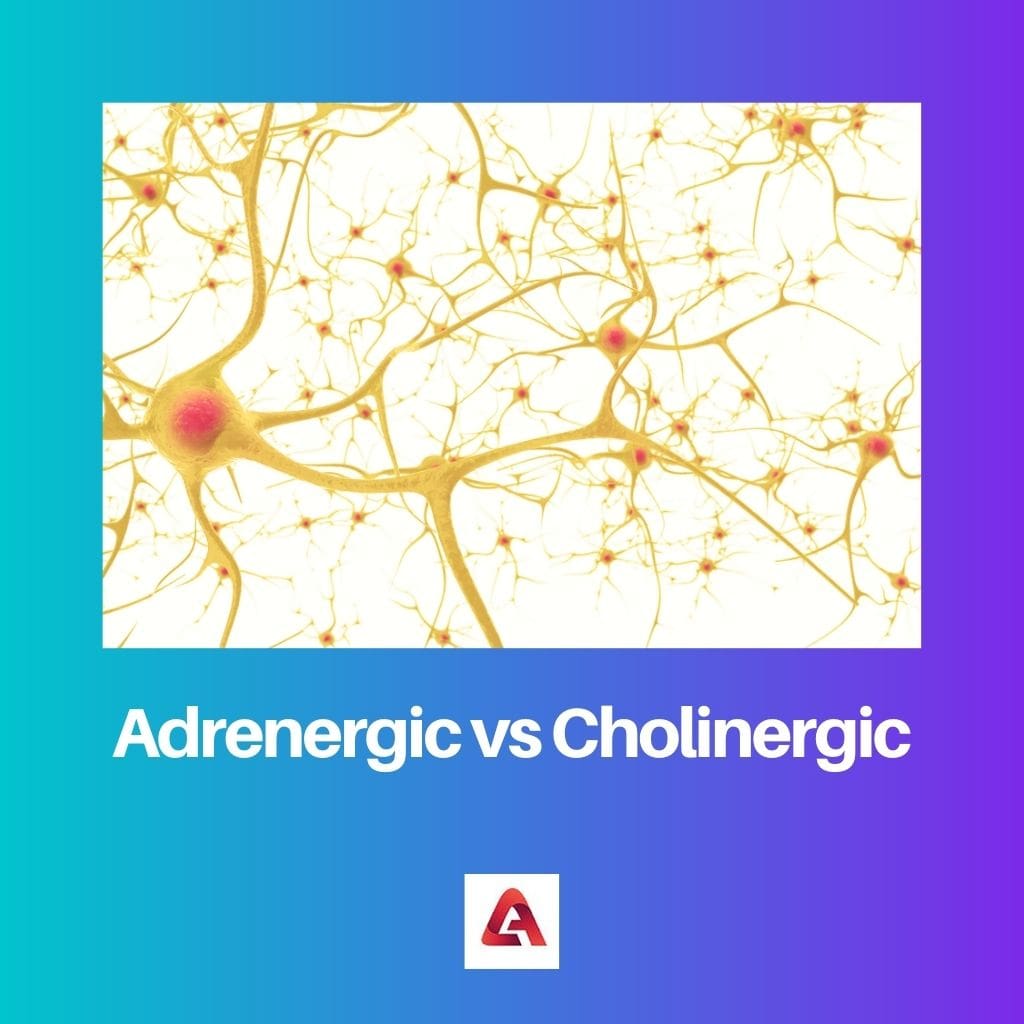Adrenergic and cholinergic are two pathways of the autonomous nervous system of our body that controls all the involuntary work of the body. Their differences are part of the body’s balancing system.
Key Takeaways
- Adrenergic receptors respond to neurotransmitters like adrenaline and noradrenaline, playing a role in the fight-or-flight response.
- Cholinergic receptors respond to the neurotransmitter acetylcholine, which is involved in various physiological processes, including muscle contraction and memory formation.
- Both adrenergic and cholinergic receptors are essential for the proper functioning of the nervous system, but they have distinct roles and effects on the body.
Adrenergic vs Cholinergic
Adrenergic receptors are activated by the neurotransmitter norepinephrine and epinephrine, regulating physiological responses to stress. Cholinergic receptors are activated by acetylcholine and are involved in the parasympathetic nervous system and neuromuscular junction, regulating rest and digestion.

Another key difference is that the adrenergic pathway is associated with Sympathetic Nervous System, while the cholinergic pathway is associated with the parasympathetic pathway.
Furthermore, the sympathetic nervous system related to the adrenergic pathway stimulates the heart by increasing its activity, while parasympathetic nerves related to the cholinergic pathway down-regulate the heart’s activity.
There are two types of adrenergic nerve receptors: alpha and beta, while cholinergic nerve receptors are of two types, nicotinic and muscarinic.
Adrenergic receptors are G-protein-bound receptors, while cholinergic receptors are inotropic and metabotropic.
The adrenergic pathway is responsible for the fight or flight response by releasing the catecholamines adrenalin from the adrenal gland. In contrast, the cholinergic pathway controls the digestion and rest response.
Comparison Table
| Parameter of Comparison | Adrenergic | Cholinergic |
|---|---|---|
| Part of which is the Nervous System | Sympathetic Nervous System | Parasympathetic Nervous System |
| Associated Neurotransmitter | Adrenaline and noradrenaline | Acetylcholine |
| Effect on heart | Stimulates faster activity | Downregulates activity |
| Types | Alpha and Beta | Nicotinic and muscarinic |
| Working of Receptor | G-protein coupled receptor | Intropic-ligand-gated and metabotropic receptors |
What is Adrenergic?
Adrenergic nerves are a part of the Sympathetic nervous system that houses the adrenergic receptors. These are G-protein coupled receptors that bind with several catecholamines that are released from the adrenal gland.
The two main neurotransmitters associated with adrenergic receptor binding are epinephrine or adrenaline and norepinephrine or noradrenaline. These are also responsible for the body’s fight-or-flight response.
When the sympathetic nerve endings in the heart bind with these neurotransmitters, they increase the heart’s activity by increasing heart rate, myocardial contractibility, and conduction velocity.
Apart from their effect on the heart, they also improve the temporary performance of the body by directing blood from unimportant organs to skeletal muscles. Other effects include dilation of pupils, increased blood pressure, expanding the lung cavity, etc.
Adrenergic receptors are of two type’s alpha and beta, which are further divided based on their function and effect on the body. When it binds to these receptors, Adrenaline causes vasoconstriction with alpha and vasodilation with beta receptors.

What is Cholinergic?
The cholinergic pathway is related to the parasympathetic nervous system that involves the functions of cholinergic receptors. These receptors are regarded as inotropic and metabotropic and are activated by the neurotransmitter Acetylcholine (ACh).
Acetylcholine neurotransmitters bind to the muscarinic and nicotinic receptors, the two main cholinergic receptors, to perform their functions. The cholinergic system drives the digestion and rest response of the body.
The vagus, or the parasympathetic nervous ending in the heart, is responsible for its cholinergic effects on it. When Acetylcholine binds to these receptors in the heart, they are responsible for down-regulating the heart’s functions.
This effect of lowering heartbeat and blood pressure by acetylcholine binding is a balancing act of the body. Other effects of acetylcholine include dilating blood vessels, increasing bodily secretions and smooth muscle contraction.
These receptors are found all over the body but mainly in the target organs such as sensory glands, respiratory tracts, heart, eyes, and gastrointestinal tract. They are also found in the somatic efferent nerves in the skeletal muscles.
Cholinergic receptors are part of the Somatic and Autonomic nervous systems and are divided into Nicotinic and Muscarinic receptors. Nicotinic receptors bind to nicotine, and muscarinic receptors bind to the muscarine.

Main Differences Between Adrenergic and Cholinergic
- The main difference between adrenergic and cholinergic is that adrenergic involves adrenaline and noradrenalin, whereas cholinergic involves using the neurotransmitter Acetylcholine.
- Another key difference is that adrenergic receptors are present in the sympathetic nervous system, while cholinergic receptors are in the parasympathetic nervous system.
- Adrenergic receptor binding induces improved heart activity and overall body performance, while cholinergic receptor binding down-regulates this effect.
- Adrenergic receptors are of two types, i.e. alpha and beta receptors, while the two types of cholinergic receptors are nicotinic and muscarinic receptors.
- Adrenergic receptor works by G-protein coupling while Cholinergic are intropic-ligand gated and metabotropic receptors.



